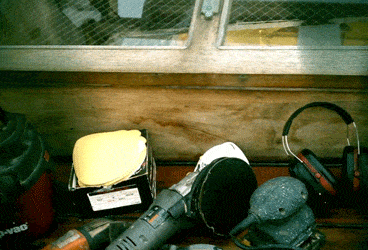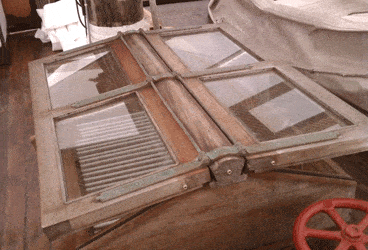
Sanding on a boat
How often do you look at your boat and see weathered varnish? Brightwork is a constant consideration on most all boats and keeping up with it often seems like a chore. The David B is certainly no exception. Every time I look at the boat, I always see some part that needs a new coat. (I use the terms brightwork and varnish interchangeably for any type of clear or amber finishes.) This winter my attention is focused on refinishing two skylights, and time permitting, fifteen teak pilothouse window sashes. The work is time consuming, but like heading out for a run in the rain, the hardest part of refinishing brightwork is getting started.
Earlier this week I began work on the foredeck skylight. My plan was to sand the panes in place. I figured I could work around the hinges with a random orbit sander, then go back with the detail sander or hand sand for the hard-to-get places. That worked for a while, but then I decided that it would be faster, easier, and look better if I took off the hinges. At first I didn’t really want to go through the hassle, but in the end, it was the right approach.
It’s been at least three years since I last did any work on the foredeck’s skylight. Its mahogany has grayed where the finish has worn off. Like every boat owner with neglected varnish, I’m always apologetic to visitors when their eyes linger a little too long on an offending spot. So with great happiness I put on my dust mask, safety glasses, and hearing protection in preparation for my sander to meet the wood. I took a deep breath and exhaled into my dust mask only to fog my glasses. I looked down at the sander and acknowledged that we would be spending a lot of time together over the next few months. I lifted it up. It was cold. I switched it on and felt it’s torque. As the sanding pad spun lightning fast, its one hundred and fifty grit ate away the gray wood. My heart warmed as orange-red hues emerged from the weathered surface. After a few minutes, the sander melded into my hands and I lost track of time. Darkness fell outside, but under the white plastic of the winter cover, two florescent lights and a halogen shop light burned as dust swirled from the sander’s pick-up into the roaring Shop-Vac. All around me was the smell of mahogany. When I bushed away the dust, my fingertips were rewarded with the feel of smooth, sander-warmed surface. I allowed myself to let my thoughts slip into the future and to think about what kind of finish I’d use, and most importantly, what the skylight will look like in the summer months as it glows brightly in the sun.

Here are a couple of tips I have for sanding a skylight:
Be patient. Don’t try to get it all done at once.
Tape or cover the glass to protect from a slipping sander.
AdvertisementRemove hinges and other projections.
If your sander has a hook up for dust collection, use tape to secure the hose to the dust pick up.
Tape the sander’s power cord to the vacuum’s hose every foot starting at the back of the sander and going back about six feet towards the vacuum.
AdvertisementDon’t try to speed up the work by using a grit that is courser than necessary. You might take off too much wood.
If you are working on deck and need to be on your knees, I recommend a pair of double front pants with kneepad inserts. Kneepads that fit into pants are possibly the greatest invention ever. They can be washed without being removed and are always there, so you never have to worry about being uncomfortable while working on your knees.
We all know how much work it takes to keep up brightwork. When I pass by a boat, even one with a small amount of varnish, I always notice and I appreciate that effort. Refinishing brightwork can be a chore, but it can also be rewarding. As when you’ve made the effort to go for that run in the rain, when you’re done, you’ll be rewarded with a feeling of satisfaction and love of yourself and your boat.









